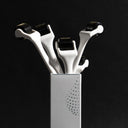Spironolactone and finasteride are two popular treatments for hair loss, each targeting hormonal causes in different ways.
In this article, we'll compare spironolactone vs finasteride to help you decide which might be the best option for your hair loss journey.
Table of content
As your leading source for hair health information over the past 4 years, we never compromise on accuracy. When it comes to your health, you deserve information you can truly rely on - and earning your trust is our top priority.
Here's how Scandinavian Biolabs ensures every piece of content meets the highest standards of accuracy and integrity:
- Credentialed Experts: Our reviewers are actively practicing doctors and medical researchers
- Stringent Reviews: Content undergoes rigorous editing by subject specialists and review by a practicing doctor.
- Evidence-Based: We rely on well-established research from trusted scientific sources like peer-reviewed journals and health authorities.
- Full Transparency: Our editorial standards, writer credentials, reviewer credentials, correction process, and funding are all publicly documented.
- Independent Voice: While we do promote products, we operate in a vacuum to business operations. Our main goal is just an unwavering commitment to providing medically-sound guidance.
You can count on Scandinavian Biolabs to consistently deliver the trustworthy health information you deserve. Read our Editorial Standards.
What is spironolactone?

Spironolactone is primarily used as a diuretic, or "water pill," to treat high blood pressure and fluid retention. However, it also has anti-androgen effects, meaning it can block the action of male sex hormones, which makes it helpful in treating a range of conditions, including hair loss in women.
In more detail, spironolactone belongs to a class of drugs known as potassium-sparing diuretics.
It works by helping the kidneys eliminate sodium and water from the body while minimising potassium loss.
Due to its anti-androgen properties, it can also be used off-label for treating conditions like hirsutism (unwanted hair growth), acne, and female pattern hair loss, all of which can be exacerbated by excess androgen hormones.
Spironolactone can slow hair thinning and promote hair growth in women suffering from androgenetic alopecia by blocking androgen receptors and decreasing androgen production.
However, it's typically not recommended for men due to its hormonal effects.
How does spironolactone work?
Spironolactone works by blocking the action of androgen hormones in the body. It does this by binding to androgen receptors and preventing these hormones from attaching, reducing their overall effects. In the context of hair loss, this anti-androgen action helps slow the process of hair thinning and can promote hair growth.
How effective is spironolactone?
Spironolactone's effectiveness can vary depending on the condition it's used to treat. In the context of female pattern hair loss, it has shown promising results in slowing down hair thinning and promoting growth.
However, the evidence must be mixed, and more high-quality, large-scale studies are required to establish its efficacy definitively.
Individual responses can vary with any medication, and discussing treatment options with a healthcare provider is essential.
What is finasteride?

Finasteride is a prescription medication primarily used to treat male pattern baldness and benign prostatic hyperplasia (BPH). It works by inhibiting the enzyme 5-alpha reductase, which converts testosterone into dihydrotestosterone (DHT), a hormone that can contribute to hair loss and prostate growth.
Further, finasteride's mechanism of action makes it a valuable tool in managing conditions sensitive to DHT. In the case of hair loss, DHT can shrink hair follicles, leading to thinner, shorter hairs and, eventually, hair loss.
Finasteride can slow down or even reverse this process in some individuals by inhibiting the conversion of testosterone to DHT.
While it's typically prescribed for men due to its potential side effects in women, it has been used off-label in post-menopausal women or those not planning to conceive.
However, women of childbearing age should not use finasteride due to the risk of birth defects.
How does finasteride work?
Finasteride works by inhibiting the enzyme 5-alpha reductase, which is responsible for converting testosterone into its more potent form, dihydrotestosterone (DHT). By reducing DHT levels, finasteride can help slow down or even reverse the process of hair miniaturisation and hair loss caused by androgenetic alopecia.
How effective is finasteride?
Finasteride is generally considered effective in treating male pattern hair loss, with many clinical trials showing it can slow the progression of hair loss and even improve hair growth in some men. However, its effectiveness in women must be clarified, with more mixed results reported and fewer high-quality studies available.
Individual responses can vary with any medication, so discussing treatment options and potential side effects with a healthcare provider is crucial.
Spironolactone vs finasteride: What are the differences?
Spironolactone blocks androgens, the hormones that can cause hair loss, while finasteride inhibits the enzyme that converts testosterone into DHT, a key factor in hair follicle miniaturization. Both aim to reduce hair loss but work through different mechanisms.
Here are the differences in detail:
Mechanism of action
Spironolactone operates as an anti-androgen, blocking androgen receptors and reducing androgen production, which can slow hair thinning and promote hair growth in women.
In contrast, finasteride inhibits the enzyme 5-alpha reductase, which converts testosterone into DHT, a hormone that can contribute to hair loss and prostate growth.
Typical usage
Spironolactone is primarily used as a diuretic for treating high blood pressure and fluid retention but also sees off-label use for conditions like female pattern hair loss and acne.
On the other hand, finasteride is mainly used to treat male pattern hair loss and benign prostatic hyperplasia (BPH).
Effectiveness
Spironolactone has shown promise in treating female pattern hair loss, although the evidence is mixed, and more large-scale studies are needed.
Finasteride, however, is generally considered effective in treating male pattern hair loss, with fewer high-quality studies available on its effectiveness in women.
What are the side effects of spironolactone and finasteride?

While both Spironolactone and Finasteride have been celebrated for their role in combating hair loss, it's equally crucial to understand their potential side effects.
Side effects of spironolactone:
- Increased urination, potentially leading to dehydration if fluid intake isn't properly managed.
- Dizziness
- Nausea
- Headaches
- Menstrual irregularities (more severe but less common)
- Breast tenderness (more severe but less common)
- Postural hypotension: a drop in blood pressure upon standing (more severe but less common)
- Possible impact on potassium levels, with a risk of hyperkalemia, which is characterised by high potassium levels in the blood (regular monitoring is necessary)
Side effects of finasteride:
- Decreased libido
- Erectile dysfunction
- Ejaculation disorder
- Mood changes, including instances of depression
- Risk of a specific type of birth defect, meaning women who are pregnant, or might become pregnant, should not handle finasteride.
An effective alternative to spironolactone and finasteride

The Bio-Pilixin® Serum by Scandinavian Biolabs is a specially formulated serum designed to nourish hair follicles and enhance the appearance of hair.
Uniquely designed with multiple plant growth factors cultivated through advanced stem cell technology, this serum nourishes hair follicles and promotes healthy hair growth at the root.
This serum has undergone clinical testing, revealing noticeable changes in the look of hair in as little as 45 days.
Bio-Pilixin® Serum aims to nourish hair follicles and enhance the appearance of hair. In a clinical study, 93% of users reported they were satisfied with the changes they saw in their hair.
This plant-powered serum is safe for daily use and designed to give your hair the care and stimulation it needs to thrive.
Every ingredient in the serum is of the highest quality, carefully selected based on a thorough review of scientific literature.
Capilia Longa, a nutrient-rich medium derived from Curcuma longa stem cells, showed in clinical studies a reduction in hair loss for some participants by up to 89–90% and an improvement in hair density by 52%.
Niacinamide provides the strength needed for sustained hair growth by improving blood flow and protecting hair follicles from premature death due to oxidative stress caused by pollution and UV rays.
This triad of powerhouse ingredients makes the Bio-Pilixin® Serum a game-changer in hair care.
Finally, we stand by the effectiveness of our Bio-Pilixin® Serum. If you are unsatisfied with the results, we offer a money-back guarantee after 150 days.
Spironolactone vs finasteride: Which one is right for you?
Spironolactone is often used in women with pattern hair loss, while finasteride is typically used in men due to the potential risks to pregnant women.
Discussing these factors and your medical history with your healthcare provider is crucial to making an informed decision.
Whether spironolactone or finasteride is right for you depends on several factors, including your gender, overall health, the specific type of hair loss you're experiencing, and your personal tolerance to potential side effects.
Conclusion
To wrap up, spironolactone and finasteride are viable treatment options for hair loss.
They function through different mechanisms and have distinct effectiveness and side effect profiles, making personalised treatment crucial.
While spironolactone is commonly used in women, men often favour finasteride due to its potential risks in pregnant women.
The decision to use spironolactone, finasteride, or another treatment should be made in consultation with your healthcare provider, considering your specific type of hair loss, overall health, and tolerance to potential side effects.
Informed decisions pave the way for a successful journey in managing hair loss.
FAQs
Does spironolactone cause hair loss in women?
No, spironolactone does not cause hair loss in women. In fact, it's often used off-label to treat female pattern hair loss due to its anti-androgen properties.
Can men use spironolactone for hair loss?
While spironolactone is effective in treating hair loss in women, it's typically not recommended for men due to its potential to cause feminising side effects, such as breast enlargement.
Read this: Spironolactone for hair loss
Is finasteride safe for women to use for hair loss?
Finasteride is generally not recommended for women, especially those of childbearing age, due to the risk of causing birth defects. However, in some cases, it may be used off-label in post-menopausal women or those not planning to conceive.
How long does Finasteride or Spironolactone take to show hair loss results?
Finasteride and spironolactone typically require several months (usually around 3 to 6 months) to show noticeable results for hair loss. The timeline can vary from person to person based on factors like the severity of hair loss and an individual's response to medication.
References:
- https://www.ncbi.nlm.nih.gov/pmc/articles/PMC3509882/
- https://www.jaad.org/article/S0190-9622(98)70007-6/abstract
- https://pubmed.ncbi.nlm.nih.gov/9777765/
- https://www.ncbi.nlm.nih.gov/pmc/articles/PMC3969676/
- https://www.sciencedirect.com/science/article/pii/S0022202X15529357






